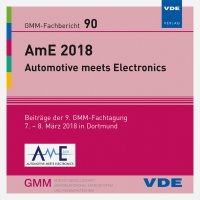uC-Based ATE for Testing a DUT provided with Real-World Failure Models
Konferenz: AmE 2018 – Automotive meets Electronics - 9. GMM-Fachtagung
07.03.2018 - 08.03.2018 in Dortmund, Deutschland
Tagungsband: AmE 2018 – Automotive meets Electronics
Seiten: 6Sprache: EnglischTyp: PDF
Persönliche VDE-Mitglieder erhalten auf diesen Artikel 10% Rabatt
Autoren:
Uygur, Guerkan; Magerl, Wolfgang; Soergel, Wolfgang; Sattler, Sebastian M. (Chair of Reliable Circuits and Systems, LZS, Friedrich-Alexander-Universität Erlangen-Nürnberg, Paul-Gordan-Str. 5, 91052 Erlangen, Germany)
Inhalt:
We present our prototype ATE solution for testing a device of elementary digital as well as analog functions provided with real-world failure models as a jumper construction. A modeled open circuit failure is done by unplugging the (normally plugged) respective jumper, and analogously a modeled short circuit failure is done by plugging the (normally unplugged) respective jumper. The DUT is supplied by a current limited voltage power supply. The programmable current limitation activates the overcurrent relay to protect the device in case of short circuit failure. The ATE resources for stimuli, measure and test evaluation are provided by an adequate uC-Board with programmable analog-to-digital io-channels. The test automation is implemented by the firmware of the uC, which corresponds to the test program of a conventional ATE including the pin-mapping, the test function library and the test flow (schedule). With this in mind, we are speaking about the Micro-ATE (uATE). Within the use case above, we discuss the challenge for localization of the so called dominated (dominent) faults, which are not detectable uniquely due to the dominating faults within the scope of the stuck-at failure modeling. At this case the testing accuracy has to be enhanced. We solve this problem definition by deploying external current sources to provide additional stimuli at the given test points. Our approach results in the overall data modeling, which covers the test tree, the test flow, and the diagnose flow for fault localization.


